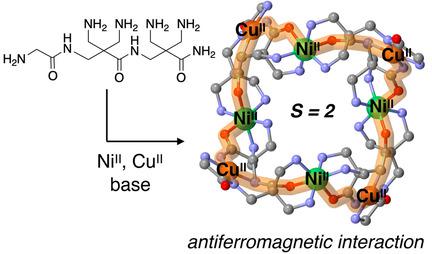当前位置:
X-MOL 学术
›
Angew. Chem. Int. Ed.
›
论文详情
Our official English website, www.x-mol.net, welcomes your
feedback! (Note: you will need to create a separate account there.)
Cyclic Heterometallic Interactions formed from a Flexible Tripeptide Complex Showing Effective Antiferromagnetic Spin Coupling
Angewandte Chemie International Edition ( IF 16.1 ) Pub Date : 2020-11-18 , DOI: 10.1002/anie.202013373 Ryosuke Miyake 1, 2 , Eri Suganuma 1 , Shun Kimura 3, 4 , Hirotoshi Mori 5 , Jun Okabayashi 6 , Tetsuro Kusamoto 4
Angewandte Chemie International Edition ( IF 16.1 ) Pub Date : 2020-11-18 , DOI: 10.1002/anie.202013373 Ryosuke Miyake 1, 2 , Eri Suganuma 1 , Shun Kimura 3, 4 , Hirotoshi Mori 5 , Jun Okabayashi 6 , Tetsuro Kusamoto 4
Affiliation

|
Developing tunable motifs for heterometallic interactions should be beneficial for fabricating functional materials based on cooperative electronic communications between metal centers. Reported here is the efficient formation of cyclic heterometallic interactions from a complex containing an artificial tripeptide with metal binding sites on its main chain and side chains. X‐ray structural analysis and X‐ray absorption spectroscopy revealed that the cyclic metal–metal arrangements arise from the amide groups connecting four square‐planar CuII centers and four octahedral NiII centers in a cyclic manner. UV/Vis spectral studies suggested that this efficient formation was achieved by the selective formation of the square‐planar CuII centers and a crystallization process. Magnetic measurements using SQUID clarified that the cyclic complex represented the S=2 spin state at low temperatures due to effective antiferromagnetic interactions between the NiII and CuII centers.
中文翻译:

由柔性三肽复合物形成的环状异金属相互作用显示出有效的反铁磁自旋耦合
开发用于异金属相互作用的可调图案应有利于基于金属中心之间的协作电子通信来制造功能材料。这里报道的是由含有人工三肽的复合物有效形成环状异金属相互作用,该复合物在其主链和侧链上具有金属结合位点。X射线结构分析和X射线吸收光谱表明,环状金属-金属排列是由酰胺基团以循环方式连接四个方形平面Cu II中心和四个八面体Ni II中心而产生的。UV / Vis光谱研究表明,这种有效的形成是通过选择性形成正方形的Cu II来实现的中心和结晶过程。使用SQUID进行的磁测量结果表明,由于Ni II和Cu II中心之间的有效反铁磁相互作用,环状配合物在低温下代表S = 2自旋态。
更新日期:2020-11-18
中文翻译:

由柔性三肽复合物形成的环状异金属相互作用显示出有效的反铁磁自旋耦合
开发用于异金属相互作用的可调图案应有利于基于金属中心之间的协作电子通信来制造功能材料。这里报道的是由含有人工三肽的复合物有效形成环状异金属相互作用,该复合物在其主链和侧链上具有金属结合位点。X射线结构分析和X射线吸收光谱表明,环状金属-金属排列是由酰胺基团以循环方式连接四个方形平面Cu II中心和四个八面体Ni II中心而产生的。UV / Vis光谱研究表明,这种有效的形成是通过选择性形成正方形的Cu II来实现的中心和结晶过程。使用SQUID进行的磁测量结果表明,由于Ni II和Cu II中心之间的有效反铁磁相互作用,环状配合物在低温下代表S = 2自旋态。











































 京公网安备 11010802027423号
京公网安备 11010802027423号